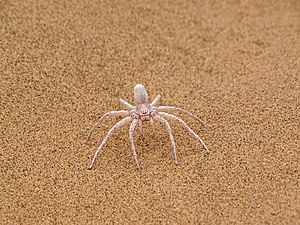Leucorchestris arenicola
| Leucorchestris arenicola | ||||||||||||
|---|---|---|---|---|---|---|---|---|---|---|---|---|

Leucorchestris arenicola |
||||||||||||
| Systematics | ||||||||||||
|
||||||||||||
| Scientific name | ||||||||||||
| Leucorchestris arenicola | ||||||||||||
| Lawrence , 1962 |
Leucorchestris arenicola is aspecies of spider from the family of giant crab spiders (Sparassidae) endemic to the Namibian desert. Adults reach a diameter of about 10 cm and weigh about 5 g. The animals spend the hot hours of sunshine protected at the end of 30–40 cm long living tubes under the sand surface. At night they leave the apartment tubes to look for food and partners and are up to 100 meters away from their location. The spider communicates by drumming its forelegs on the sand surface and can feel these vibrations for several meters. The rhythmic movements gave Leucorchestris arenicola its common name Dancing White Lady .
More types
A few other species of spider are called White Lady . The African wheel spider Carparachne aureoflava - also from the Namib - is often called (Dancing) White Lady Spider in addition to its common trivial name Wheel Spider , and the species of the genus Cerbalus , which occur in North Africa and the Middle East, are also mentioned in terraristics . referred to as the White Lady .
literature
- Hallan, Joel 2006: SYNOPSIS OF THE DESCRIBED ARANEAE OF THE WORLD Texas A&M University Department of Entomology.
- John R. Henschel: Long-distance wandering and mating by the Dancin White Lady Spider (PDF, 306 kB) The Journal of Arachnology 30, pp. 321-330, 2002
- Diemut Klärner: Desert spiders - return home in the dead of night. . In: FAZ, September 12, 2006, No. 212 / page 34
- Senckenberg Natural History Museum: On the trail of desert dancers - giant crab spiders in the Namib
- Thomas Norgaard: Nocturnal Navigation in Leucorchestris arenicola, The Journal of Arachnology 33, 553-540